Overview
The article titled "10 Environmental Social Governance Metrics for Effective Land Acquisition" identifies crucial metrics that organizations must consider to enhance their land acquisition processes in alignment with environmental, social, and governance (ESG) standards. It highlights the significance of metrics such as:
- Carbon footprint assessment
- Diversity and inclusion indicators
- Employee engagement
- Supply chain sustainability
- Community impact evaluations
These metrics collectively empower organizations to achieve responsible and equitable land procurement practices.
In today's complex landscape of land acquisition, organizations face numerous challenges, including legal and regulatory hurdles. By focusing on these essential metrics, organizations can navigate these complexities effectively, ensuring that their land acquisition strategies are both sustainable and socially responsible.
Implementing these metrics not only enhances compliance with ESG standards but also fosters a culture of accountability and transparency within organizations. As they assess their carbon footprint, promote diversity, and engage with employees and communities, organizations can create a positive impact that resonates beyond their immediate operations.
In conclusion, adopting these metrics is not merely a compliance exercise; it is a strategic imperative that positions organizations as leaders in responsible land acquisition. By prioritizing ESG considerations, organizations can drive meaningful change and contribute to a more sustainable future.
Introduction
In a world where energy and infrastructure development is rapidly evolving, the significance of effective land acquisition practices has never been more critical. Harbinger Land stands at the forefront of this challenge, offering a suite of comprehensive services tailored to meet the unique demands of the industry. By leveraging advanced technology and a skilled team, the company is dedicated to enhancing operational efficiency and client satisfaction.
As the landscape of land acquisition continues to shift, understanding the metrics behind sustainability, diversity, employee engagement, and compliance becomes essential for organizations aiming to navigate this complex terrain. This article delves into the multifaceted aspects of land acquisition, exploring how these key metrics not only drive success but also foster equitable and sustainable practices that benefit communities and stakeholders alike.
Harbinger Land | Comprehensive Solutions for Land Acquisition in Energy and Infrastructure
Harbinger Land stands out in the realm of land procurement services, adeptly addressing the complexities associated with energy and infrastructure initiatives throughout the United States. Their comprehensive offerings encompass site and right-of-way procurement, title research, GIS mapping, and advanced data processing. By leveraging cutting-edge technology, including efficient document imaging solutions, Harbinger Land enhances operational efficiency and elevates client satisfaction in title research and leasing.
As CEO, John underscores the value of a passionate and skilled team, asserting, "As CEO, I grow, lead, and support a team of passionate, articulate, likable, and smart experts." This commitment to effective leadership ensures that the company's experienced team can swiftly mobilize resources to meet diverse project requirements, delivering timely and precise services to a varied clientele, which includes natural gas companies, solar developers, and municipalities.
Recent insights from the National Association of Home Builders (NAHB) reveal that 118 builders participated in their Q1 2025 survey, underscoring the growing importance of efficient property procurement strategies in today's market landscape. This statistic emphasizes the need for companies to adopt robust property procurement practices to remain competitive.
Moreover, Harbinger's proficiency in GIS modeling and proactive monitoring, coupled with their advanced title research solutions, ensures that property procurement processes remain sustainable and equitable, effectively addressing potential disparities in data usage.
Carbon Footprint: Measuring Environmental Impact in Land Acquisition
Assessing the carbon footprint associated with property acquisition is crucial for understanding the greenhouse gas emissions resulting from usage changes and project activities. Organizations can utilize tools like the Carbon Footprint Calculator to effectively quantify these emissions and identify reduction strategies.
Current statistics reveal a significant correlation between usage changes and greenhouse gas emissions, with NOAA monitoring the atmospheric CO2 growth rate showing consistent increases since 1959. Notably, the correlation between the central estimates of the annual flux from Greenhouse Gas Observation and Monitoring Systems (GOBMs) stands at 0.94, underscoring the strong link between usage changes and greenhouse gas emissions.
By diligently monitoring environmental social governance metrics, companies can enhance their sustainability profiles and demonstrate a robust commitment to environmental stewardship—an increasingly prioritized factor by stakeholders.
Furthermore, as Lin Guo observes, 'Longitudinal studies examining the long-term impacts of persistent property price increases on corporate sustainability transitions would also offer valuable insights.' This perspective underscores the importance of understanding these dynamics to inform future strategies in property development initiatives.
Diversity and Inclusion: Key Metrics for Equitable Land Acquisition Practices
Diversity and inclusion indicators in property procurement are essential for promoting fair practices that accurately reflect the demographics of affected communities. Key metrics include the percentage of diverse contractors engaged in initiatives, which is critical for ensuring that local enterprises benefit from property development activities. Furthermore, community representation in decision-making processes is paramount; organizations that actively involve local voices can significantly enhance trust and legitimacy in their efforts.
Outreach initiatives targeting underrepresented groups are also vital. Successful programs have shown that when companies prioritize engagement with diverse communities, they not only improve their social license to operate but also contribute to more sustainable outcomes. For instance, organizations that have implemented robust diversity strategies report increased levels of community support and reduced resistance to initiatives. In 2025, diversity and inclusion statistics reveal that companies with diverse contractor involvement experience enhanced performance and improved community relations. Additionally, the unemployment rate for foreign-born workers in the U.S. was 3.4% in 2022, underscoring the importance of integrating diverse talent into teams for better results. As companies navigate economic challenges and political shifts, reassessing their diversity, equity, and inclusion (DEI) commitments will be crucial for long-term success. This reassessment is particularly significant as numerous organizations are currently evaluating their DEI strategies in light of these changes.
Case studies illustrate the impact of these measurements. For example, organizations that have effectively executed diversity initiatives in property procurement have reported not only improved community relations but also increased project efficiency. Notably, companies like UPS, which invests $2.6 billion annually in its Supplier Diversity Program, exemplify how substantial investment in diversity initiatives can yield improved outcomes. By focusing on these indicators, companies can ensure that their property procurement practices are fair, transparent, and representative of the communities they serve.
As Lean In points out, women occupy 1 in 4 C-suite positions, while women of color hold only 1 in 16, emphasizing the urgent need for greater representation in leadership roles within the sector. By addressing these disparities, companies can further enhance their diversity and inclusion initiatives in property procurement.
Employee Engagement: Metrics to Enhance Workforce Motivation in Land Acquisition
Employee engagement indicators, including turnover rates, job satisfaction scores, and training program participation, are vital for cultivating a motivated workforce in property development projects. Regular evaluation of these indicators allows organizations to pinpoint areas needing improvement and implement targeted strategies that enhance employee morale and productivity.
A notable case study demonstrated that 92% of employees reported increased engagement after participating in formal training programs, highlighting the necessity of investing in employee development. Furthermore, with 40% of employees indicating that their current employer is aware of their job search, fostering a supportive work environment is essential for retaining talent and minimizing turnover rates in the real estate sector.
As an Inspirus specialist remarked, "If you're struggling with turnover, chat with an Inspirus specialist to see how a strategic recognition program can help you build a workplace where employees feel valued — and want to stay."
By prioritizing these engagement measures and employing data-driven strategies, organizations can develop a more motivated workforce, ultimately leading to more successful property procurement outcomes.
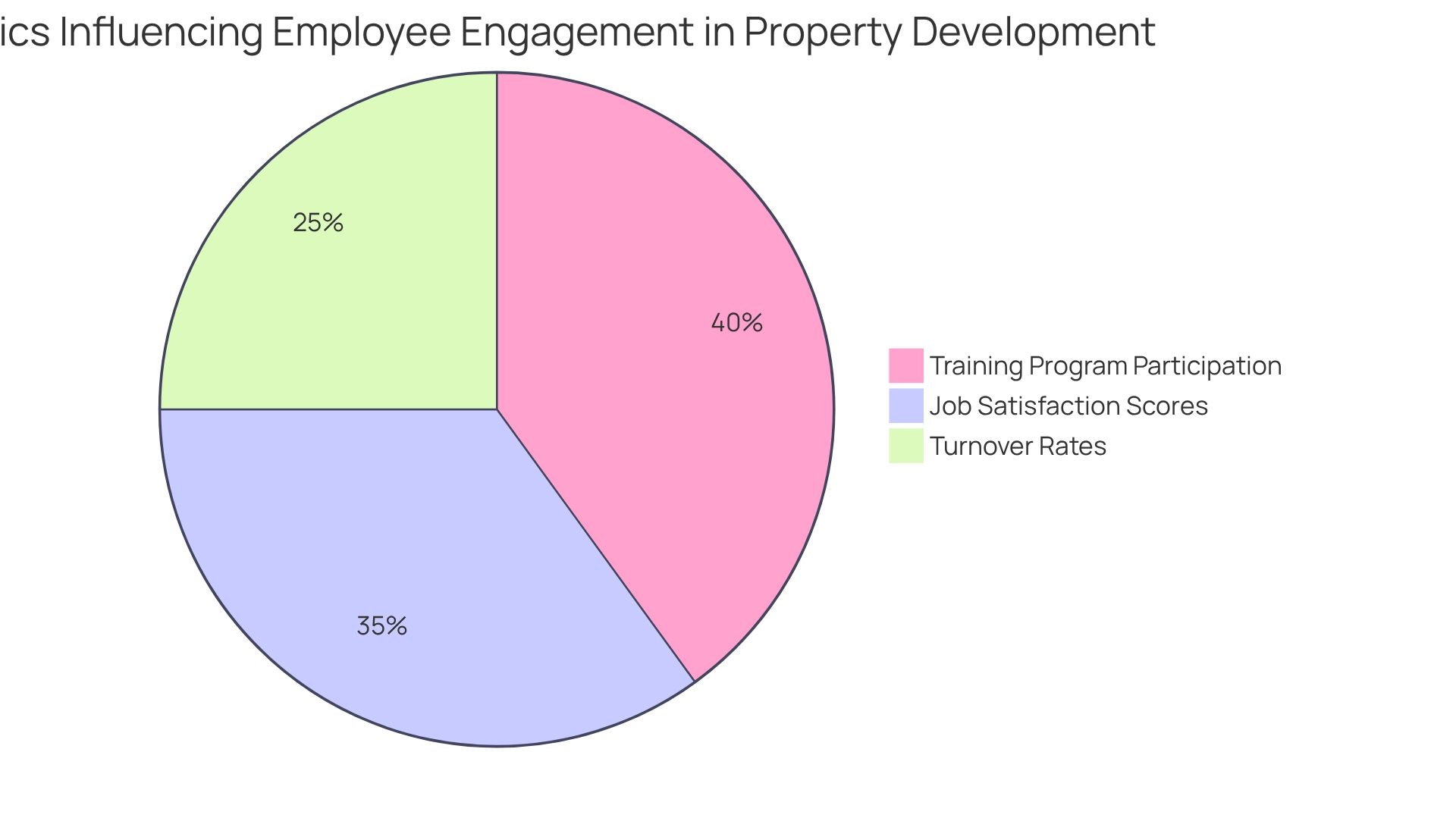
Supply Chain Sustainability: Metrics for Responsible Land Acquisition
Metrics for supply chain sustainability in land procurement are essential for aligning operations with environmental social governance metrics and goals. How can organizations ensure they meet these critical objectives? Key indicators include:
- Assessing the environmental impact of suppliers
- Ensuring compliance with sustainability criteria
- Monitoring resource utilization throughout the procurement process
By adopting comprehensive frameworks to systematically evaluate environmental social governance metrics, organizations can enhance their corporate social responsibility profiles while mitigating risks related to environmental degradation. Prioritizing responsible sourcing not only fosters innovation—evidenced by a 20% increase in innovation linked to sustainable procurement practices—but also ensures that land procurement strategies yield benefits for both the environment and society.
Additionally, waste reduction strategies, which focus on minimizing production byproducts, reusing materials, and recycling waste, are vital components of responsible sourcing that should be integrated into environmental social governance metrics, as highlighted in case studies such as 'Evaluating Environmental Risks and Compliance,' which underscore the importance of environmental due diligence in target selection. This emphasizes the necessity of assessing regulatory compliance and environmental liabilities. Such a proactive approach aids in making informed decisions, enhancing sustainability, and reducing financial burdens post-acquisition.
Furthermore, a recent study revealed that 94% of Chief Procurement Officers (CPOs) surveyed indicated that their senior leadership teams and CEOs are increasingly interested in sustainable procurement processes. This trend highlights the escalating significance of sustainability at the executive level. Sustainable startups are also creating lasting value while safeguarding the planet, further illustrating the critical role of sustainability in property development.
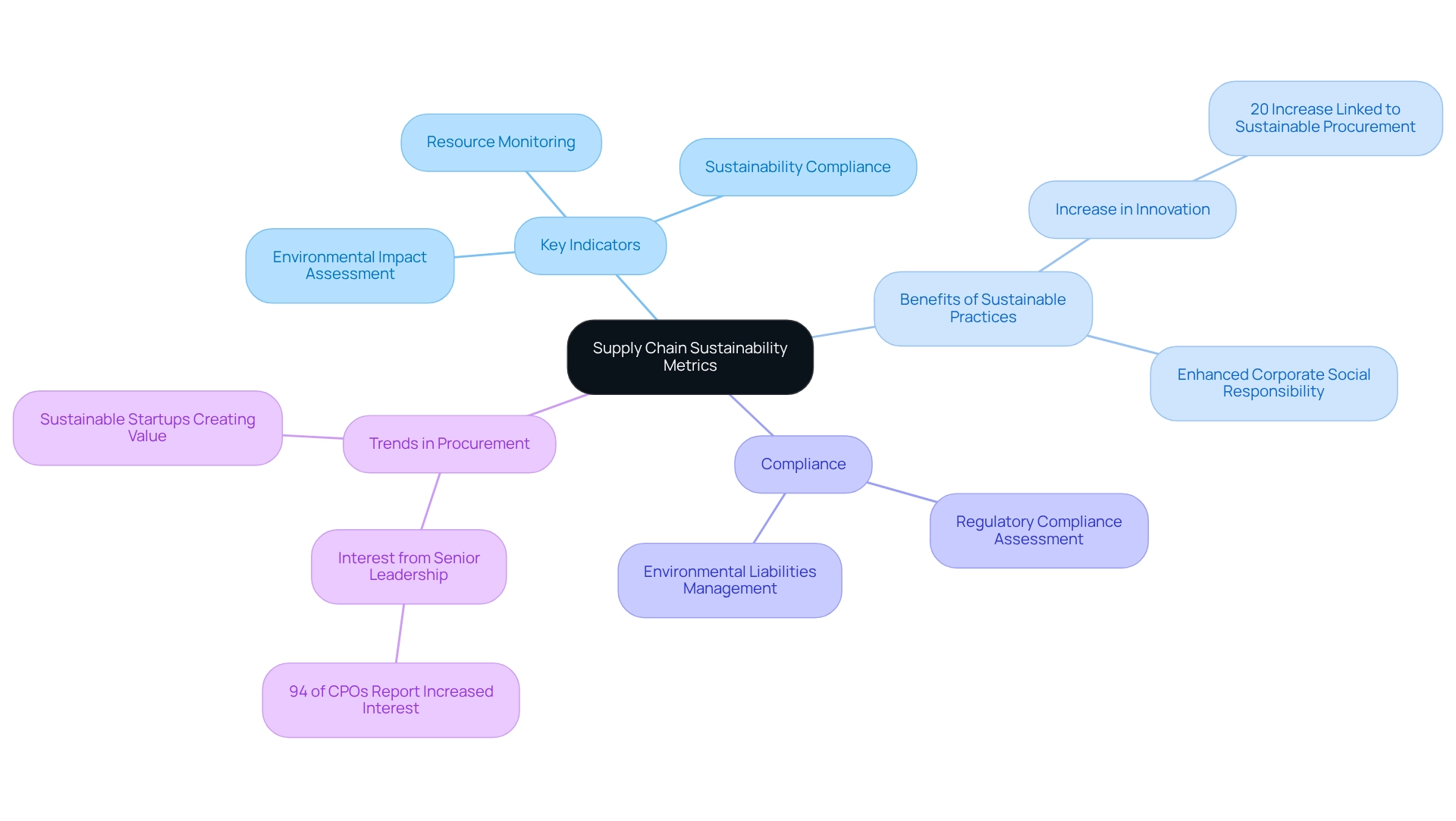
Community Impact: Metrics for Evaluating Land Acquisition Effects on Local Populations
Assessing the community effect of property procurement requires a multifaceted strategy that integrates metrics such as shifts in local employment rates, community satisfaction surveys, and evaluations of infrastructure enhancements. Recent studies reveal that property-expropriated women exhibit a 0.042 increase in the likelihood of seeking employment within their counties, underscoring the nuanced effects of acquisition on local demographics. Furthermore, there is an urgent need for more research on the gendered impacts of property expropriation on employment, an area that remains underexplored.
Engaging with local stakeholders is essential; their feedback can yield valuable insights into the social ramifications of projects, thereby directly influencing outcomes. For instance, a case study on urban expansion in Chengdu, China, demonstrated significant reductions in cultivated areas due to development pressures. This case highlights the critical necessity for coordinated policies that balance urban growth with agricultural preservation. Such policies could encompass zoning regulations, use planning, and community engagement initiatives, ensuring that both development and agricultural needs are met.
By prioritizing community well-being and actively assessing these impacts, organizations can enhance their reputation and foster long-term relationships with local populations. This approach ultimately leads to more sustainable and socially responsible property procurement practices. As Akira Mori aptly stated, 'In my experience, in the real-estate business, past success stories are generally not applicable to new situations. We must continually reinvent ourselves, responding to changing times with innovative new business models.' This perspective emphasizes the importance of flexibility in addressing the evolving challenges of property procurement.
Governance Metrics: Ensuring Compliance and Ethical Standards in Land Acquisition
Governance measurements in property procurement are crucial for ensuring compliance with local, state, and federal regulations, while also upholding ethical standards and transparency in decision-making processes. Organizations must establish comprehensive policies and procedures that guide ethical and legal property procurement activities. Regular audits and assessments are vital for identifying areas for improvement, fostering a culture of accountability, and enhancing overall compliance health.
Consider the application of automation tools such as SmartCompliance; they have proven effective in monitoring compliance measures. This enables organizations to conserve time and minimize mistakes while focusing on key performance indicators. The outcome of utilizing automated compliance solutions not only streamlines processes but also offers a competitive edge in compliance health.
Starting in 2025, compliance with ethical standards in property procurement transcends mere regulatory obligation; it becomes a competitive advantage. This shift underscores the necessity for organizations to prioritize environmental social governance metrics within their operational strategies. To effectively implement these environmental social governance metrics, organizations should:
- Conduct regular training sessions for staff
- Leverage technology for real-time compliance tracking
- Establish clear communication channels for reporting compliance issues
By taking these actions, organizations can not only meet regulatory demands but also position themselves favorably in a competitive landscape.
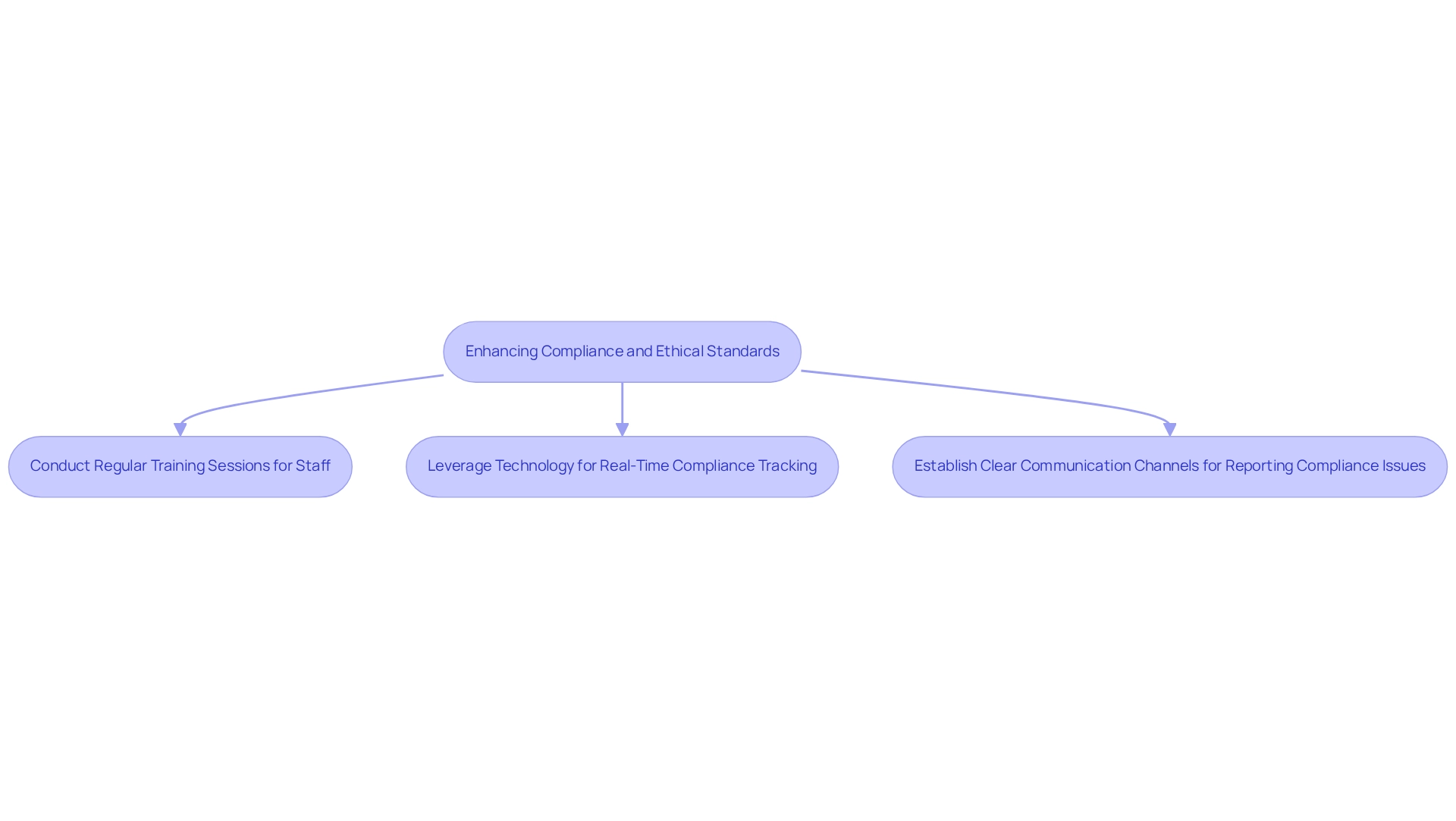
Risk Mitigation: Metrics for Identifying and Managing Land Acquisition Risks
Efficient risk reduction in property procurement hinges on the detection and management of potential legal, environmental, and financial risks inherent to this domain. A recent examination of 1,835 construction progress monitoring-related journal articles underscores the critical significance of risk evaluation in property procurement initiatives. Organizations must engage in thorough due diligence, employing structured risk assessment frameworks to identify vulnerabilities specific to land procurement.
Creating contingency plans tailored to identified risks is essential for enhancing resilience. By proactively managing these risks, companies can streamline procurement processes and facilitate smoother transitions. Effective frameworks for recognizing risks in property development initiatives necessitate the incorporation of comprehensive measures that address legal factors and environmental social governance metrics, ensuring that all potential obstacles are anticipated and managed effectively. Notably, tax risk falls within the broader category of legal risks, emphasizing the importance of a comprehensive understanding of all legal implications.
Moreover, case studies reveal that meticulous planning, efficient communication, and a focus on change management and user acceptance are vital in navigating the complexities of mergers. This approach ultimately leads to improved outcomes and the retention of key talent.
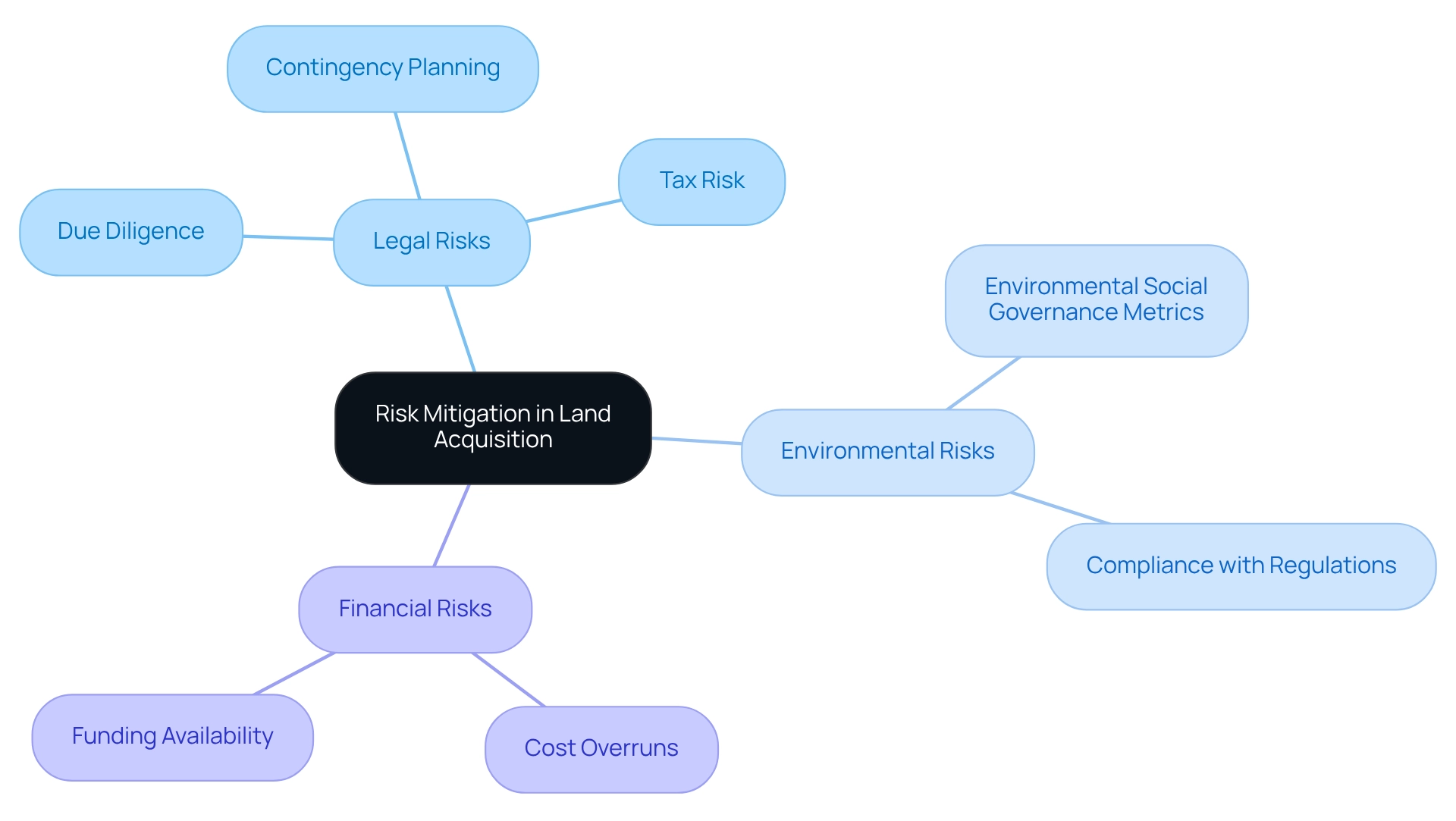
Transparency and Communication: Metrics for Building Stakeholder Trust in Land Acquisition
Transparency and communication measurements in land acquisition are vital for fostering stakeholder trust and cooperation. Essential metrics include the frequency and clarity of updates provided to stakeholders, the accessibility of information related to the initiative, and the responsiveness to community inquiries. Organizations must prioritize establishing open communication channels and delivering regular updates to stakeholders. This approach not only builds trust but also enhances credibility. Given that renewable energy leases typically span twenty to thirty years, continuous communication is crucial for long-term success.
Consider the impact of effective communication strategies, which can significantly reduce resistance to land acquisition initiatives. Case studies, such as 'Innovative Solutions for Sustainable Solar Energy Development,' illustrate how customized approaches to stakeholder engagement lead to successful outcomes. Furthermore, leveraging intelligent tools can yield an additional 2–5% in revenue per endeavor, creating a clear distinction between profit and loss, as highlighted by Justin Lew, Real Estate Development Manager.
Additionally, Harbinger Land's efficient document imaging solutions streamline title research and leasing processes, ensuring that property data is digitized and readily accessible. This capability not only enhances transparency but also supports timely communication with stakeholders. Ultimately, this paves the way for smoother project execution and stronger stakeholder relationships.
Regulatory Compliance: Metrics for Navigating Legal Requirements in Land Acquisition
Effective regulatory compliance metrics in property procurement are essential for tracking adherence to zoning laws, environmental regulations, and usage policies. Organizations must implement detailed compliance checklists and conduct regular audits to ensure that all procurement activities align with legal requirements. This proactive approach minimizes legal risks and bolsters operational integrity.
Consider this: 91% of business leaders recognize their responsibility to address Environmental, Social, and Governance (ESG) issues. This statistic reflects a significant shift in corporate priorities, highlighting the need for organizations to adapt. Furthermore, as of 2025, 62% of compliance officers dedicate 1 to 7 hours weekly to monitor regulatory developments, a decrease from 73% in 2022. This trend indicates a growing efficiency in compliance tracking, which is vital in property procurement, where timely updates can greatly influence project outcomes.
Moreover, with 53% of companies leaving sensitive data accessible to all staff, ensuring compliance in safeguarding sensitive information during property procurement processes is crucial. As Sharavanan pointed out, 78% of companies worldwide have emphasized zero trust, underscoring the significance of security in compliance standards. By prioritizing these metrics, companies can navigate the complexities of land acquisition while ensuring adherence to evolving regulations and safeguarding sensitive information.
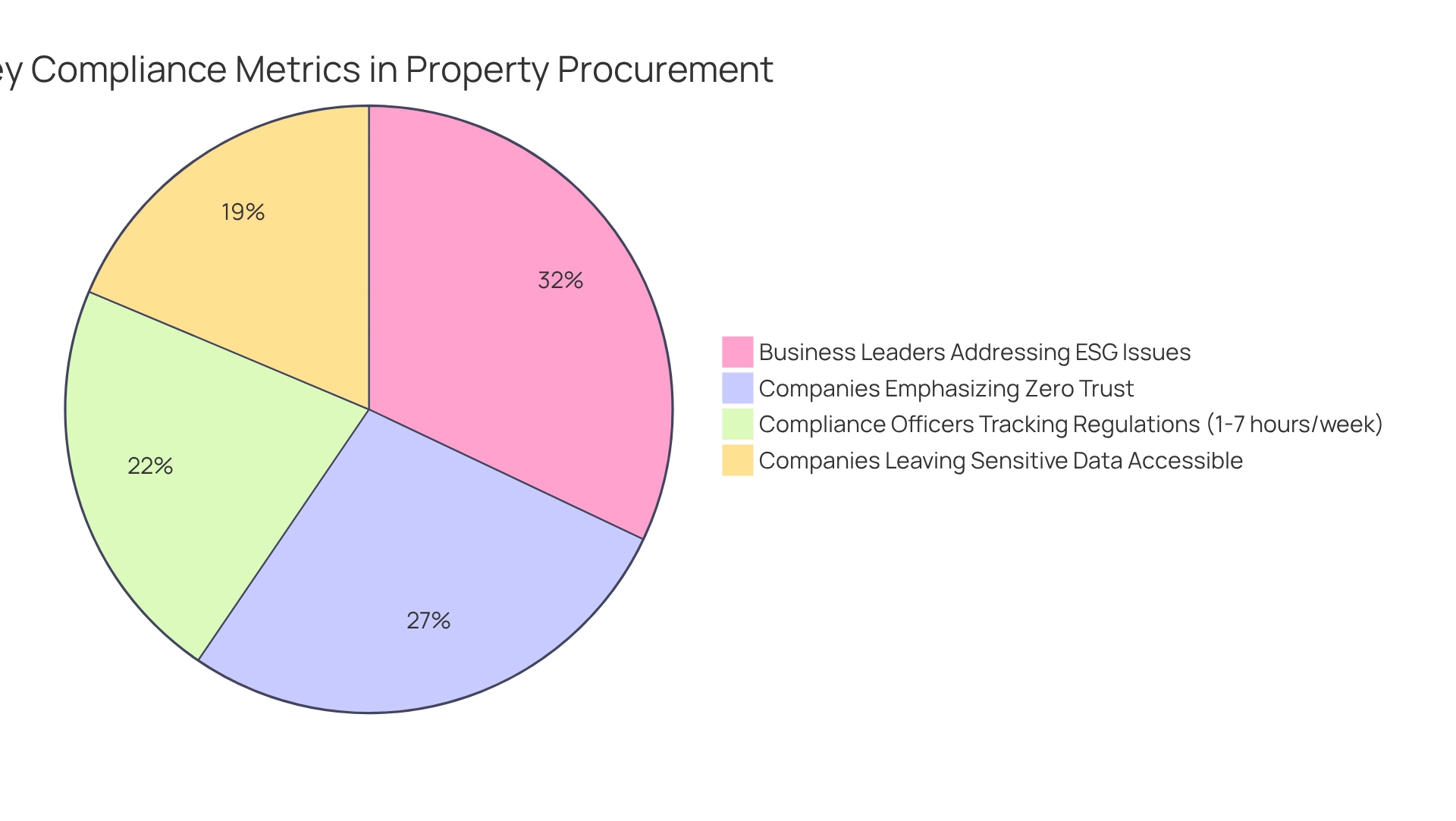
Conclusion
The significance of effective land acquisition practices in energy and infrastructure development cannot be overstated, as evidenced by the multifaceted metrics discussed throughout this article. Harbinger Land exemplifies a steadfast commitment to enhancing operational efficiency through advanced technology and a skilled workforce, ensuring timely and accurate services for a diverse clientele. The integration of sustainability metrics—such as measuring carbon footprints and promoting responsible sourcing—highlights the critical role organizations play in minimizing environmental impact and fostering corporate social responsibility.
Diversity and inclusion metrics emerge as vital components for equitable land acquisition practices. By actively engaging with underrepresented communities and prioritizing diverse contractor participation, companies can build trust and improve project outcomes. Furthermore, employee engagement metrics underscore the importance of cultivating a motivated workforce, which in turn contributes to successful land acquisition strategies.
The necessity of governance and compliance metrics is also emphasized to uphold ethical standards and regulatory adherence. By implementing systematic approaches to risk management, transparency, and communication, organizations can navigate the complexities of land acquisition while fostering stakeholder trust and community support.
Ultimately, the evolving landscape of land acquisition demands a comprehensive understanding of these key metrics. By prioritizing sustainability, diversity, employee engagement, and governance, organizations can enhance their operational effectiveness and contribute positively to the communities they serve. As the industry continues to advance, embracing these principles will be essential for achieving long-term success and fostering equitable and sustainable outcomes.
Frequently Asked Questions
What services does Harbinger Land offer in land procurement?
Harbinger Land provides services such as site and right-of-way procurement, title research, GIS mapping, and advanced data processing, all aimed at addressing the complexities of energy and infrastructure initiatives.
How does Harbinger Land enhance operational efficiency?
The company leverages cutting-edge technology, including efficient document imaging solutions, to improve operational efficiency and client satisfaction, particularly in title research and leasing.
What is the leadership philosophy of Harbinger Land's CEO?
CEO John emphasizes the importance of a passionate and skilled team, stating that he aims to grow, lead, and support a team of experts who can swiftly mobilize resources to meet project requirements.
What recent insights highlight the importance of efficient property procurement strategies?
A Q1 2025 survey by the National Association of Home Builders (NAHB) involved 118 builders, indicating the growing significance of effective property procurement strategies in the current market landscape.
How does Harbinger Land ensure sustainability in property procurement?
Harbinger Land employs GIS modeling and proactive monitoring alongside advanced title research solutions to maintain sustainable and equitable property procurement processes.
Why is assessing the carbon footprint important in property acquisition?
Understanding the carbon footprint associated with property acquisition helps quantify greenhouse gas emissions resulting from usage changes and project activities, which is crucial for organizations aiming to reduce their environmental impact.
What tools can organizations use to monitor their carbon emissions?
Organizations can utilize tools like the Carbon Footprint Calculator to quantify emissions and identify strategies for reduction.
How do diversity and inclusion indicators impact property procurement?
These indicators promote fair practices in property procurement, ensuring that local enterprises benefit from development activities and enhancing community trust through local representation in decision-making processes.
What benefits do companies experience when prioritizing diversity in property procurement?
Companies that engage diverse contractors report improved community relations, increased project efficiency, and a stronger social license to operate.
What statistics highlight the current state of diversity in leadership roles?
Women occupy 1 in 4 C-suite positions, while women of color hold only 1 in 16, indicating a significant need for greater representation in leadership within the sector.
List of Sources
- Harbinger Land | Comprehensive Solutions for Land Acquisition in Energy and Infrastructure
- AD&C Financing Survey (https://nahb.org/news-and-economics/housing-economics/indices/adc-financing-survey)
- Low Risk Land Acquisition (https://jbrec.com/insights/the-light-low-risk-land-acquisition)
- The Ultimate Guide to Land Acquisition in Real Estate (https://blog.harbingerland.com/the-ultimate-guide-to-land-acquisition-in-real-estate)
- Carbon Footprint: Measuring Environmental Impact in Land Acquisition
- Global Carbon Budget 2022 (https://essd.copernicus.org/articles/14/4811/2022)
- Impact of land prices on corporate carbon emission intensity - Scientific Reports (https://nature.com/articles/s41598-025-86102-y)
- Global Carbon Budget 2024 (https://essd.copernicus.org/articles/17/965/2025)
- Diversity and Inclusion: Key Metrics for Equitable Land Acquisition Practices
- Diversity In The Workplace Statistics To Know For 2025 (https://elearningindustry.com/diversity-in-the-workplace-statistics-to-know)
- 100+ Diversity And Inclusion Statistics You Must Know In 2025 (https://inclusiviteasy.com/magazine/diversity-and-inclusion-statistics)
- Supplier Diversity Statistics 2025 – 35 Key Figures (https://procurementtactics.com/supplier-diversity-statistics)
- 140+ Workplace Diversity Statistics for 2025 (https://resumegenius.com/blog/career-advice/workplace-diversity-statistics)
- Employee Engagement: Metrics to Enhance Workforce Motivation in Land Acquisition
- 20 Employee Engagement Statistics You Need to Know | HR Cloud (https://hrcloud.com/blog/20-employee-engagement-statistics-you-need-to-know)
- Employee Engagement & Loyalty Statistics: The Ultimate Collection (https://blog.accessperks.com/employee-engagement-loyalty-statistics-the-ultimate-collection)
- Employee Engagement Statistics Across Industries (https://rcademy.com/employee-engagement-statistics-across-industries)
- 70 Pivotal HR Statistics for 2025 (https://performyard.com/articles/hr-statistics)
- 2025 Employee Retention & Turnover Statistics You Need to Know (https://inspirus.com/blog/employee-turnover-statistics)
- Supply Chain Sustainability: Metrics for Responsible Land Acquisition
- Sustainable Procurement Statistics — 50 Key Figures of 2025 (https://procurementtactics.com/sustainable-procurement-statistics)
- Supply Chain Trends for 2025: Innovation, Sustainability, and Resilience (https://scw-mag.com/news/supply-chain-trends-for-2025-innovation-sustainability-and-resilience)
- Evaluating Environmental Risks In Land Acquisition - FasterCapital (https://fastercapital.com/topics/evaluating-environmental-risks-in-land-acquisition.html)
- Community Impact: Metrics for Evaluating Land Acquisition Effects on Local Populations
- Employment of Land-Expropriated Farmers: The Effects of Land Expropriation and Gender Difference (https://mdpi.com/2073-445X/12/10/1955)
- Employment situation of households after land acquisition. (https://researchgate.net/figure/Employment-situation-of-households-after-land-acquisition_tbl2_338456227)
- 20 Famous Real Estate Investing Quotes (https://realtymogul.com/knowledge-center/article/20-famous-real-estate-investing-quotes)
- Governance Metrics: Ensuring Compliance and Ethical Standards in Land Acquisition
- Famous Quotes in the Law | Law Offices of Gary Green (https://ggreen.com/just-for-fun/famous-quotes-in-law)
- Essential Compliance Metrics for 2025: How to Track and Improve Your Compliance Program - SmartCompliance (https://smartcompliance.co/blog/essential-compliance-metrics-for-2025-how-to-track-and-improve-your-compliance-program)
- 2025 Code of Ethics & Standards of Practice (https://nar.realtor/about-nar/governing-documents/code-of-ethics/2025-code-of-ethics-standards-of-practice)
- City of New York - Land Acquisition Statistics (https://catalog.data.gov/dataset/land-acquisition-statistics)
- Risk Mitigation: Metrics for Identifying and Managing Land Acquisition Risks
- Figure 5 :Risk Computation model of land Acquisition risk (https://researchgate.net/figure/Risk-Computation-model-of-land-Acquisition-risk_fig9_334544431)
- Mitigating Risks And Challenges In Land Acquisition - FasterCapital (https://fastercapital.com/topics/mitigating-risks-and-challenges-in-land-acquisition.html)
- 5 Effective ways of Managing Development Risks in Real Estate (https://brickstone.africa/managing-development-risks)
- Transparency and Communication: Metrics for Building Stakeholder Trust in Land Acquisition
- Transparency & Reports - NYCHA (https://nyc.gov/site/nycha/about/reports.page)
- Evaluating Land Acquisition for Solar Projects: A Comprehensive Case Study (https://blog.harbingerland.com/evaluating-land-acquisition-for-solar-projects-a-comprehensive-case-study)
- Your project update faces scrutiny over data accuracy. How will you reassure a skeptical stakeholder? (https://linkedin.com/advice/1/your-project-update-faces-scrutiny-over-2fdwc)
- Regulatory Compliance: Metrics for Navigating Legal Requirements in Land Acquisition
- 100+ Compliance Statistics You Should Know (https://sprinto.com/blog/compliance-statistics)
- Key Compliance Statistics & Insights For 2025 | Zluri (https://zluri.com/blog/key-compliance-statistics-and-insights-for-2024)




